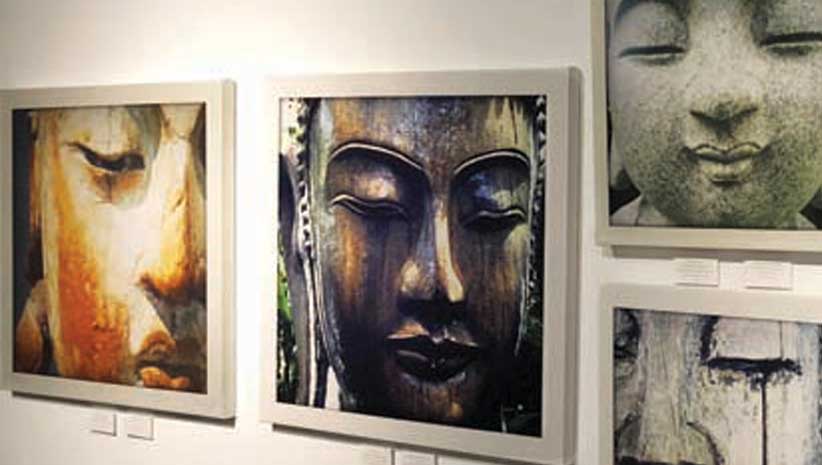
Photos by Natalie Ford, the exhibit’s creator. These are part of her collection, Sacred Art Series, Faces of Peace: The Buddha—photos of Buddha she has taken all over the world. She meditates and tunes in to each Buddha she shoots to get the right name and message for that Buddha. She sees animal treatment as part of “compassion for all living things, including the earth, the animals, and yourself,” noting that at the end of yoga classes, many sing the Sanskrit chant, Loka Samastha Sukhino Bhavantu. (May all beings in the world be happy and free.) “It’s important to represent your spirituality with meaningful action,” she says, and her vegan diet and view of animals flows from that. “Humans are not the only beings in the world that are suffering,” she says. New York’s Tibet House quoted the Dalai Lama when it showed Ford’s Buddha series: “If warriors would think of the face of the Buddha before they strike a blow or before they light a fire, maybe they would restrain themselves from doing that act of violence.”
Photographers act on their vision of animal advocacy in a compassionate and sustainable world.
“The greatness of a nation and its moral progress can be judged by the way its animals are treated.” — Mahatma Gandhi
“My love for animals touches everything I do,” says APA Award-winning photographer Natalie Ford, who recently organized a one-night exhibit of nine distinguished fine-art photographers. The evening was designed to raise awareness and compassion for animals and their place in the world, and, specifically, to raise funds for START Rescue (Shelter Transport Animal Rescue Team).
START Rescue is a nonprofit that rescues dogs and cats from high-kill shelters in California and finds placement in homes in the Pacific Northwest. It has also funded more than 5,500 spay/neuter surgeries for low-income families, and rescues some animals from Mexico and from South Korea where the animals are tortured as part of the process of improving their taste.
The Lois Lambert Gallery, in Santa Monica’s Bergamot (Station) arts center, donated its space for an event that drew artists, collectors, celebrities, philanthropists, and animal advocates from a range of communities.
“This is actually the fifth fine art photo show I have curated,” says Ford, “but the first group show that has included all compassionate photographers.” To Ford, there is a spirituality and sacredness to the photography itself; the captured energy of a moment that passes between the artist and the subject and connects to the viewer. “The deep truths of photographic images are raw and pure,” she says.
Ford and the other photographers at this exhibit join a long tradition of artists and celebrities who have used their talents and voices to encourage the ethical treatment of animals and point a wider lens on its implications for global health, spirituality, and the environment.
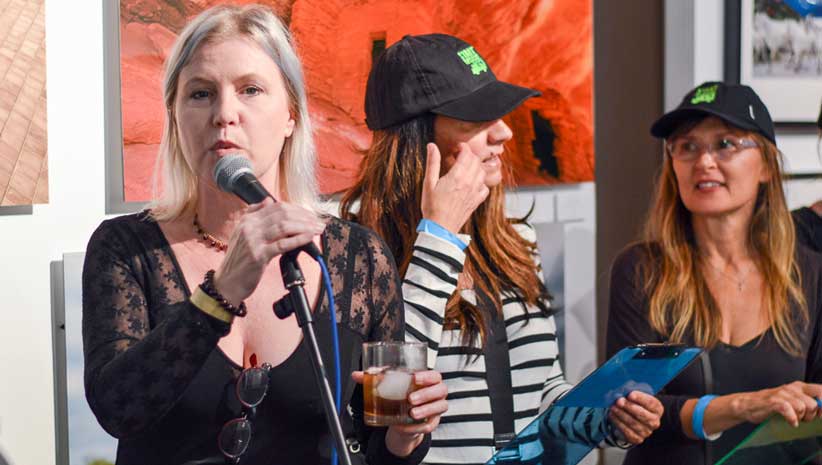
Photographer and event creator Natalie Ford, with event volunteers. Photo by Sarah Singer of Sarah Singer Photography.
Supporting START Rescue
While START Rescue’s co-founders Steve Spiro and Rene Ruston rescue 100 to 150 animals a month from shelters, they are not fully heartened. “I’ve got a picture on my phone of us clearing out a whole section of a shelter,” says Spiro. “That was on a Thursday. Friday, it was full again.” But, the increasing numbers of rescue and spay/neuter groups overall gives them hope. And, Ruston says they see the dramatic difference the spay/neuter part of their mission is making, which she says is important “because we realized we’re not going to transport our way out of these problems.”
Like most of the photographers at this exhibit, Ruston and Spiro see animal treatment as part of a larger story. And the larger story has to do with “compassion and what we’re doing to the environment,” says Ruston.
Animal Agriculture and Climate Change
“Animal agriculture is a leading cause of climate change, far beyond all transportation combined,” explains Jane Velez-Mitchell, a national and local on-air TV journalist for 40 years. She covered the photography event as the editor of her nonprofit digital animal rights and lifestyle news outlet JaneUnchained.com. “That
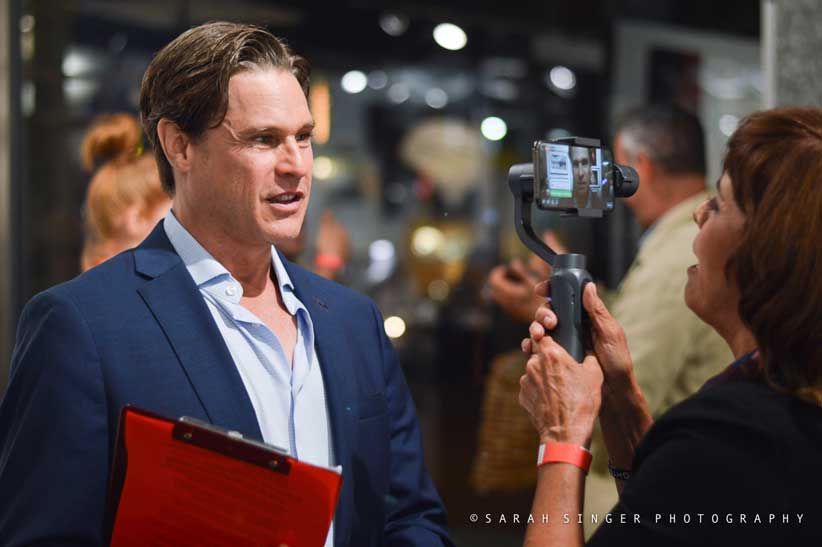
Billy McNamara and Jane Velez-Mitchell. Photo by Sarah Singer of Sarah Singer Photography.
As Velez-Mitchell reads the numbers, “If we don’t stop animal agriculture . . . we’re going to have an ecological collapse that is going to make Hurricane Florence, Hurricane Maria, and all those other storms look like a tea party. We are literally mowing down the planet to grow crops. Not to feed people, but to feed those animals. . . Our wild areas are being decimated. And [a recent New York Times article] says it’s from human behavior. But it’s really not human behavior, it’s the specific human behavior that is animal agriculture.”
Many of the people at the event seemed to share a common knowledge—the 70+ billion farm animals that are killed each year for food and fur, the destruction of land, the health dangers, the dangers to indigenous cultures, the emissions, and the widespread suffering it causes.
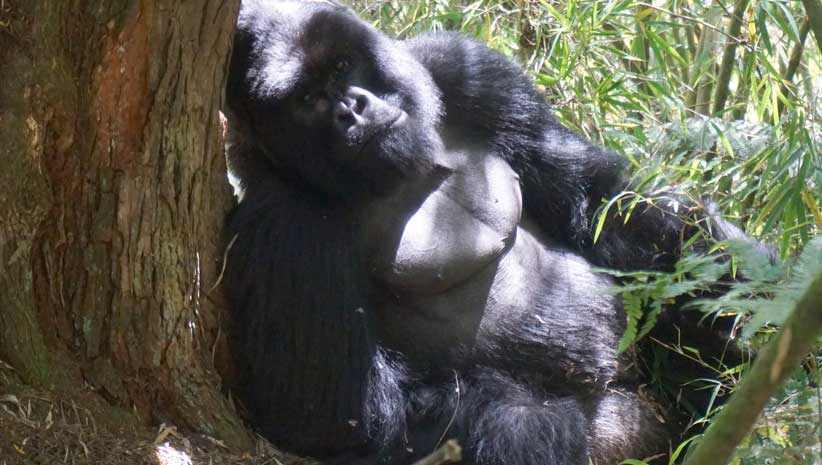
Mountain gorilla, Volcanoes National Park, Rwanda. Photo by Cindy Landon.
Photographer Cindy Landon
Photographer Cindy Landon says as an animal advocate for many years, she has learned a lot about the plight of African wildlife. “The poaching, and knowing they are slaughtered for their tusks and horns, is heartbreaking. Trophy hunting is another horrific act I can’t wrap my head around. Every 15 minutes an elephant is killed, and they say in the next 10 years they’ll become extinct.”
Landon is the widow of actor Michael Landon (“Highway to Heaven,” “Little House on the Prairie,” “Bonanza”), who died of cancer in 1991. “I gave up eating meat when I was 14, a young girl. I couldn’t eat it because I felt, and feel, I could never hurt anything. I made the connection probably at five years old, but my family convinced me to eat meat. And at 14, I finally said no more. And I became vegan about 18 years ago.”
An experienced traveler, she says Africa is her favorite place. “This last trip was the first time I witnessed the Great Migration [of wildebeests] and went trekking with wild gorillas. After seeing my first group of gorillas I broke down in tears. To see these amazing animals so close up, and to stand in quite solitude and have this experience, was beyond words. I am saddened knowing that if drastic measures aren’t taken, perhaps my grandchildren will not have the opportunity to share in these extraordinary moments.”
“Self-awareness is also part of the answer,” says Cindy Landon. “We’ve been told that we’re not going to be able to keep raising animals this way much longer. But a change is happening slowly, especially in Los Angeles and New York. And, for me, it’s how do you take an animal, torture it, keep it in these factory farms and these crates, then slaughter them horrifically, and then sit down and eat them? Just spiritually and consciously, I can’t imagine how anybody can do that. So, I’m hopeful that people will wake up more and do things differently.
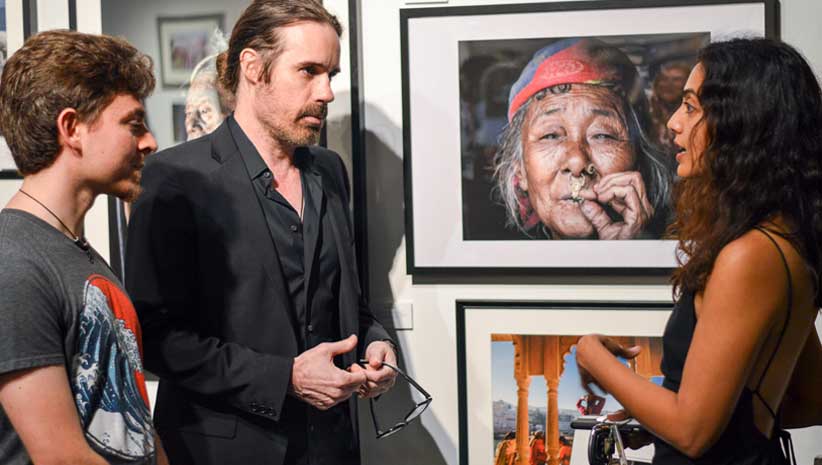
Photographer Sej Saraiya, with Scott Bramer (L) and Michael Petted; with her photos in the background. Photo credit: Sarah Singer of Sarah Singer Photography.
Photographer Sej Saraiya
Sej Saraiya, an award-winning photographer from India who documents indigenous and vanishing cultures, was invited to exhibit at this event and also coproduced it. “One reason I photograph indigenous people and their sacred lands,” says Saraiya, “is because these are places where there’s a direct connection between human beings and animals; something we need to bring back to our planet in order to save it.”
Recently, Saraiya was invited to mentor at a filmmaking and storytelling program for First Nations people in British Columbia. While there, she spent time with an old Nlaka’pamux medicine woman, who taught her about medicinal plants and herbs. “She was appalled at how little I knew,” says Saraiya. “She invited me to go medicine-picking with her, saying we would go at sundown, because in the morning the forest belongs to the animals, who go berry picking and catch fish. After they’re done for the day, the forest is ours.’ She taught me to put down an offering after collecting the food and herbs; an apple or an orange, or tobacco. ‘You trade. We respect Mother Earth because that’s where our food and medicines come from. We pray to the birds because they’re our winged brothers and sisters. And we respect the four-legged, the deer, the horse, the cows, the moose, the bear; they’re all our brothers and sisters.’ And to me, that was really beautiful, because we don’t talk like that; we don’t think like that. We think everything is ours to be exploited. We don’t really respect the other beings the way they do. ‘We can’t go in the forest to pick herbs because it’s the animals’ hour.’ So beautiful. Why don’t we think like that?”
Billy McNamara: The James Bond of Animal Activism
The fine-art photography fundraiser was hosted and MC’d by Billy McNamara, a film and television actor, and also the producer of such documentaries as Nat Geo Wild Network’s “Animal Intervention,” an exposé of the U.S. exotic animal industry. He is a longtime animal rights activist—with an emphasis on “active.”
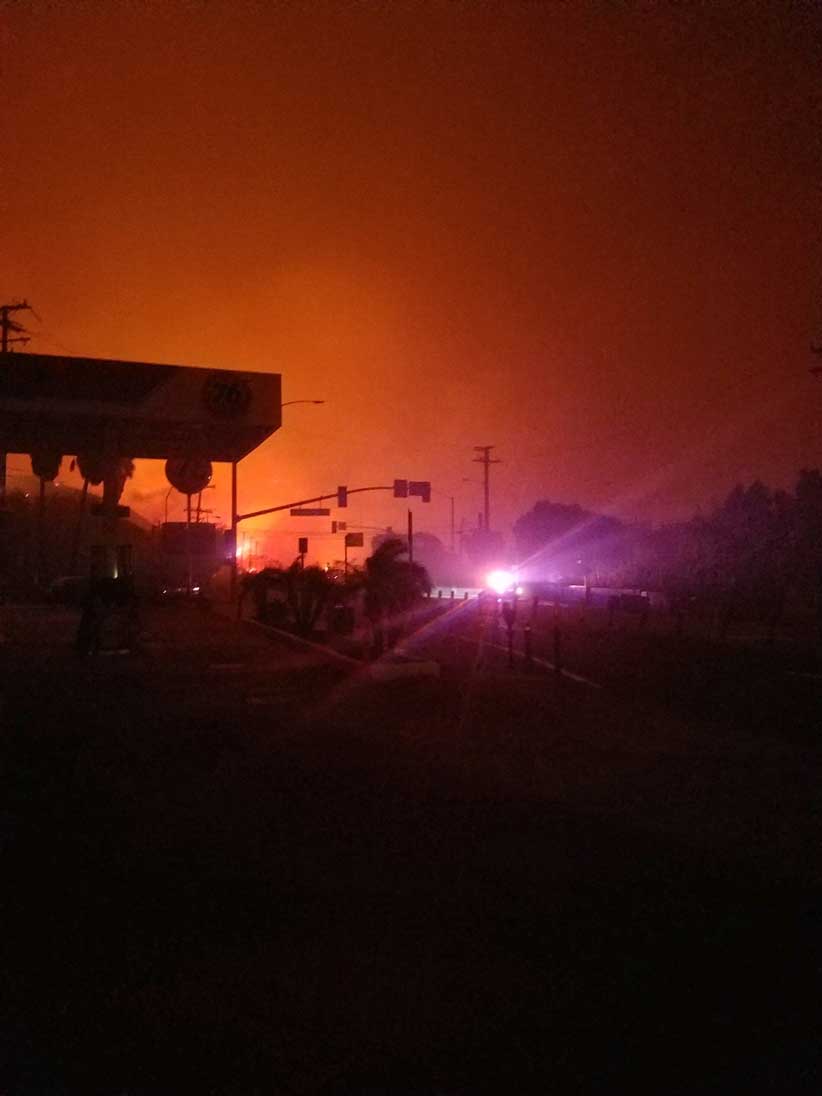
The fall 2018 fire in Malibu. Cellphone photo by Billy McNamara.
During the recent Malibu fires, McNamara stayed up for three days straight avoiding flames, jumping fences, breathing smoke, and working with firefighters and others to rescue two horses (among other animals), give them hourly water, investigate the safety of the 250 safari animals (they were safe), and put out spot fires. The firefighters supported what he was doing and answered his call when he saw structures at risk. Above is a cellphone picture McNamara took at the Malibu 76 Station on PCH, where he hid between forays into the flaming hills.
In 2003, McNamara went to Taiji, Japan, with Sea Shepherd, a nonprofit conservation organization that uses “direct action” and information campaigns to protect marine life. They went to stop the town’s hidden government-sanctioned mass dolphin killings, and he was imprisoned briefly. “We were a very small team of activists and environmentalists,” he says. “We had to do some sabotage and subterfuge, and it was illegal. We were very radical and very aggressive physically. We were trained that way by Sea Shepherd.” But he notes that no humans were harmed by his efforts, saying that would have gone against the group’s humane purpose.
“I’ll tell you an interesting story,” he said. “In Taiji, the dolphins get killed with spears, and they scream. The screams are so loud, and the cove turns red with blood. And one of the things the Japanese said to us in their defense was, ‘Why are you so angry? Why do you Americans come here? The Buddhists [in a nearby Buddhist monastery] watch us do the killing, and they’re OK with it.’
“And I thought, Wow. I saw the Buddhists there in their orange robes, and I thought, ‘What the fuck?’ So I went over, and I said, ‘Anybody speak English?’ And one said, ‘Yes, I speak English.’ And I said, ‘So they said you’re OK with this, and you don’t care that they’re doing that?’ And he said, ‘We don’t make any judgment. But we’re here to witness it. We didn’t want it to happen without witnesses.’
“And I said, ‘Well don’t you want to do anything about it?’
“And one guy said: ‘You’re here.’
“In other words, ‘We’ve been praying and meditating that somebody would come. That’s what we do. We pray and meditate. And so that’s our part of it.’
“And when he said that, I thought, I get it now. It was powerful. They’re there witnessing the murder, and that’s an important thing to do. To witness. It’s not happening without people witnessing and feeling the emotion and the terribleness of it.”
More Compassion
Other fine art photographers at this exhibit included Donna Dennison, Andrei Duman, Sally Long, Carla Seidel, Todd Snyder, and Kurt Weiss.
“Events like this one for START Rescue remind people that there are more living beings on this earth besides us,” says Saraiya. “We get really busy in our 9–5’s, and then we come to this event and you see these people rescuing animals, and you see tears in everyone’s eyes. It creates a little shift in us.”
Jeffrey Ainis is a freelance writer, book editor, and an author of books on world music and composing. He also leads kirtan around the world.
